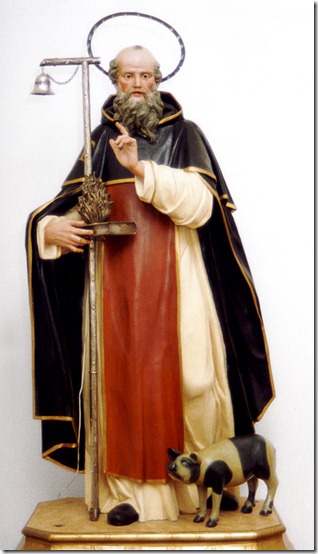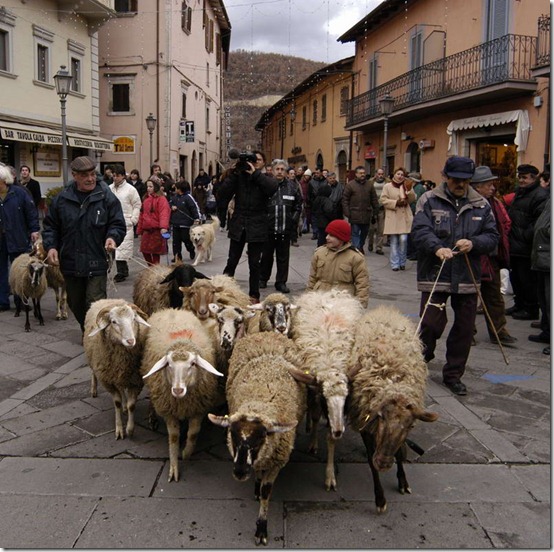Sant’Antonio Abate Posted by Serena on Jan 18, 2012 in Culture
On the 17th of January the Catholic Church commemorates Sant’Antonio Abate (Saint Anthony the Abbot), patron saint of animali domestici (pets and farm animals), macellai e quelli che lavorano il maiale (butchers and those who process pork), and coloro che sono afflitti dal fuoco di sant’Antonio (those who suffer from shingles or herpes zoster, commonly known in Italy as Saint Anthony’s fire).
Sant’Antonio Abate was born in Egypt in 251 AD. Following his parents’ death he chose to become a hermit and he lived in the desert for over 20 years, where he fought the devil who both tempted him with angelic voices and tortured him with fire. Word soon spread and many admirers and would-be disciples came to look for him. He miraculously healed people, and instructed his followers to base their lives on the Gospel. His disciples created two communities on both sides of the river Nile, where they lived in caves. Anthony died ultracentenario (over a hundred years old) in 356 AD, and his disciples buried him in a secret place, but in 561 his remains were discovered, and his relics began a long journey from Alexandria to Constantinople, ending near Viennes in France in the XI century. In this place, a monastery dedicated to Sant’Antonio Abate was founded.
Soon many people, particularly those suffering from shingles, began to come to the monastery to be healed. The condition of shingles was treated with pork fat, which helped to reduce the burning pain, and for this reason the monks were granted permission to keep pigs. The pigs were fed by the whole community and could run free in the village as long as they wore a bell around their necks. This led to the tradition of representing Sant’Antonio with a piglet at his feet (see photo below). For this reason Anthony is also known as Sant’Antonio del Porcello (Saint Anthony of the piglet), which helps to distinguish him from the later and more famous Sant’Antonio da Padova (Saint Anthony from Padua). In the south of Italy, in order to avoid confusion, Sant’Antonio Abate is called Sant’Antuono.
Sant’Antonio Abate represented with a piglet at his feet, and holding the Tau stick of a hermit, a bell, a Bible and fire.
This traditional representation of Sant’Antonio gradually led to the erroneous belief that he was the protector of pigs, and hence all farm animals, swineherds, butchers, and so on. It is for this reason that Saint Anthony’s image is traditionally placed inside or above the entrances of stables in order to protect the animals. Legend has it that on the night of the 17th of January farm animals gain the power of speech. On this date farmers stay away from their stables because overhearing the animals speaking can bring bad luck. On Saint Anthony’s day in many churches here in Italy a mass is celebrated to bless domestic animals, and people are allowed to take their pets to church.
Pecore (sheep) being led through the streets of Cascia (Umbria) on Saint Anthony’s day.
Sant’Antonio Abate’s name also has a strong link to fire. According to a legend, Sant’Antonio travelled to hell in order to try and rescue some souls from the Devil. At a certain point his piglet, which used to follow him everywhere, began running around and creating havoc. Anthony used this opportunity to steal some fire from the Devil with his bastone del Tau (the Tau stick, symbol of the hermits), which he then brought back up to earth and donated to humanity by setting fire to a stack of wood. This would seem to be a Christian version of the Greek myth of Prometheus who brought fire to mankind from the underworld. On the night of the 17th of January, in order to commemorate Saint Anthony, it is traditional in many parts of Italy to light the falò (bonfire). Last night we went to watch the falò di San Niccolò (San Niccolò is the name of the quartiere where the falò takes place here in Pontremoli). I’ll be writing a blog about this event in the near future.

Build vocabulary, practice pronunciation, and more with Transparent Language Online. Available anytime, anywhere, on any device.






Comments:
joseph:
that was very interesting. A great tradition
Andrew Abate:
This was a very thorough & concise biography. I greatly appreciate the time you dedicated to make this information available without strings or CC#s attached like so many other!
Serena:
@Andrew Abate Grazie Andrew! Parente di Sant’Antonio? 😉
Saluti da Serena
leland stark:
i have a 1885 pendant with his image on it with a divozione deicittadini campagna 1885 on back of oval shaped pendant.